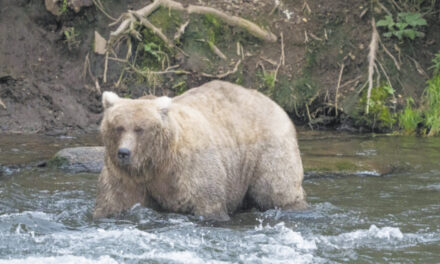San Francisco (AP) – Wildlife officials were trying to capture a wayward sea otter Thursday that has been wresting surfboards away from surfers and aggressively approaching kayakers off the coast of Santa Cruz, California.
The 5-year-old female otter has shown aggression toward people for several weeks and poses a public safety risk, the U.S. Fish and Wildlife Service said in a statement.
 Video and photographs shared on social media show the marine mammal getting on top of different surfboards, on at least one occasion biting and tearing chunks off a board, and aggressively approaching surfers.
Video and photographs shared on social media show the marine mammal getting on top of different surfboards, on at least one occasion biting and tearing chunks off a board, and aggressively approaching surfers.
A team of wildlife experts with the California Department of Fish and Wildlife and the nearby Monterey Bay Aquarium were working to capture and put the animal in a new home, the service said.
“While there have been no confirmed reports of injury, due to the highly unusual behavior of this otter, kayakers, surfers, and others recreating in the area should not approach the otter or encourage the otter’s interactions,” U.S. Fish and Wildlife Service said.
Federal wildlife officials said the otter’s behavior is highly unusual and the exact cause for such behavior is unknown.
“Aggressive behavior in female southern sea otters may be associated with hormonal surges or due to being fed by humans,” federal officials said.
The animal, which wildlife officials named sea otter 841, was born in captivity and released into the wild in June 2020. She is tagged with her number and has a radio transmitter that officials are monitoring to find and capture her, wildlife officials said.
They said it is not the first time the otter has shown aggressiveness toward humans. The sea otter was observed approaching people in late 2021. Last May, she was spotted with a pup in the Santa Cruz area and four months later exhibited similar aggressive behavior.
In September, a team of California wildlife officials and Monterey Bay Aquarium staff hazed sea otter 841 by yelling loudly at her and using a paddle to beat the water in an effort to create a negative association with people, said Kevin Connor, a spokesperson with the Monterey Bay Aquarium.
“Ultimately, that effort was not successful and as we can see, the interactions with people continued and escalated and now we’ve got an otter 841 that is very bold,” Connor said.
“We need the animal to listen to its natural survival instinct and have a healthy fear of people so it won’t approach them,” he added.
Connor said that once captured, the otter will be evaluated by aquarium vets and be given a new home in a zoo or an aquarium where she can be “an ambassador for her species.”
If she harms a person, wildlife officials would have to consider euthanizing the animal, he said.
Southern sea otters, whose population dwindled to about 50 in 1938, are managed by the U.S. Fish and Wildlife Service. They are listed as federally threatened under the Endangered Species Act and are protected under the Marine Mammal Act and California state law.
Now with a population of about 3,000, sea otters play a fundamental role in maintaining healthy coastal ecosystems by preying on sea urchins that can multiply and chomp their way through the kelp forests they share, Connor said.








